2021 CHEVROLET COLORADO air condition
[x] Cancel search: air conditionPage 16 of 89

Chevrolet/GMC 2.8L Duramax Diesel Engine Supplement (GMNA-Localizing-
U.S./Canada-14465442) - 2021 - CRC - 2/3/20
Driving and Operating 15
{Warning
Do not use gasoline or starting aids, such
as ether, in the air intake. They could
damage the engine, which may not be
covered by the vehicle warranty. They
could also cause a fire, which could cause
serious personal injury.
Engine Idle Variations
Under certain conditions the engine idle
speed can vary or be elevated. Change in
idle speed is normal and does not indicate a
problem. Normal conditions that can raise
idle speed are low voltage, DPF
regeneration, air conditioning compressor
loads, and engine warmup. These speeds can
range from approximately 600 to 1000 rpm.
Elevated Idle
The engine has a cold temperature high idle
feature which elevates the engine idle speed
from base idle to 1050 to 1100 rpm for
pickup models or 1200 rpm for van models
when outside temperatures are below 0 °C
(32 °F), and the engine coolant temperature
is below 65 °C (150 °F). This feature enhances
heater performance by raising the engine
coolant temperature faster.To turn this feature on or off on pickup
models, see
Vehicle Personalization (Van
Models) 011 or
Vehicle Personalization (Pickup Models) 011.
On van models, this feature can be turned
on and off using the DIC buttons.
When the engine is started, it will slowly
ramp up to the high idle speed after a delay
of a few seconds up to approximately
two minutes. For this method to work
properly there must be no throttle or brake
pedal faults.
The engine idle speed will return to normal
once the following conditions are met:
.Engine coolant temperature reaches 65 °C
(150 °F).
.Air intake temperature reaches 0 °C
(32 °F).
The high idle speed will be temporarily
interrupted and the engine speed will return
to normal if any of the following conditions
occur:
.The brake pedal is applied.
.The accelerator pedal is pressed.
.The transmission is shifted out of P (Park)
or N (Neutral).
.Vehicle speed is detected. Once these inputs are removed, the engine
idle speed will slowly ramp back up to high
idle after the normal delay, if the conditions
for engine coolant temperature and air
intake temperature are still met.
Fast Idle Control (Vans Only)
The vehicle may have this system which can
be used to increase the engine idle speed.
Fast Idle control will be enabled when the
following conditions are met:
.The parking brake is set.
.The transmission is in P (Park) or
N (Neutral).
.The vehicle speed is about
0 km/h (0 mph).
.The cruise control Set switch is pressed
and released for Preset Fast Idle Speed
(1200 rpm).
Fast Idle control will be disabled when one
or more of the following conditions occur:
.The cruise control Set switch is pressed
and released. See “Cruise Control”in the
owner’s manual.
.The cruise control Cancel switch is
pressed.
.The brake pedal is pressed.
Page 17 of 89
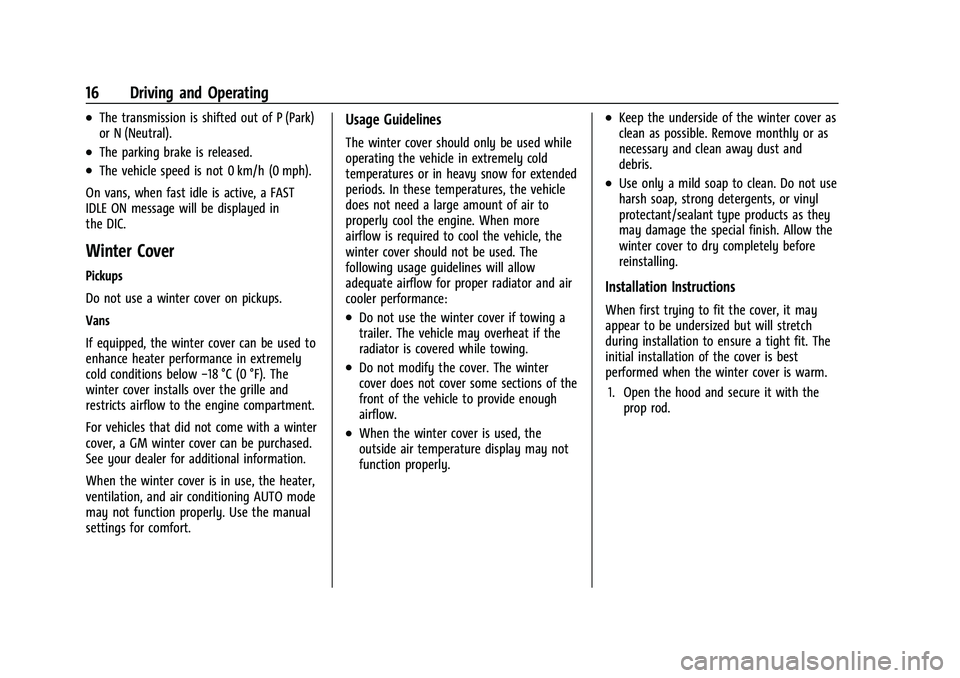
Chevrolet/GMC 2.8L Duramax Diesel Engine Supplement (GMNA-Localizing-
U.S./Canada-14465442) - 2021 - CRC - 2/3/20
16 Driving and Operating
.The transmission is shifted out of P (Park)
or N (Neutral).
.The parking brake is released.
.The vehicle speed is not 0 km/h (0 mph).
On vans, when fast idle is active, a FAST
IDLE ON message will be displayed in
the DIC.
Winter Cover
Pickups
Do not use a winter cover on pickups.
Vans
If equipped, the winter cover can be used to
enhance heater performance in extremely
cold conditions below −18 °C (0 °F). The
winter cover installs over the grille and
restricts airflow to the engine compartment.
For vehicles that did not come with a winter
cover, a GM winter cover can be purchased.
See your dealer for additional information.
When the winter cover is in use, the heater,
ventilation, and air conditioning AUTO mode
may not function properly. Use the manual
settings for comfort.
Usage Guidelines
The winter cover should only be used while
operating the vehicle in extremely cold
temperatures or in heavy snow for extended
periods. In these temperatures, the vehicle
does not need a large amount of air to
properly cool the engine. When more
airflow is required to cool the vehicle, the
winter cover should not be used. The
following usage guidelines will allow
adequate airflow for proper radiator and air
cooler performance:
.Do not use the winter cover if towing a
trailer. The vehicle may overheat if the
radiator is covered while towing.
.Do not modify the cover. The winter
cover does not cover some sections of the
front of the vehicle to provide enough
airflow.
.When the winter cover is used, the
outside air temperature display may not
function properly.
.Keep the underside of the winter cover as
clean as possible. Remove monthly or as
necessary and clean away dust and
debris.
.Use only a mild soap to clean. Do not use
harsh soap, strong detergents, or vinyl
protectant/sealant type products as they
may damage the special finish. Allow the
winter cover to dry completely before
reinstalling.
Installation Instructions
When first trying to fit the cover, it may
appear to be undersized but will stretch
during installation to ensure a tight fit. The
initial installation of the cover is best
performed when the winter cover is warm.
1. Open the hood and secure it with the prop rod.
Page 20 of 89
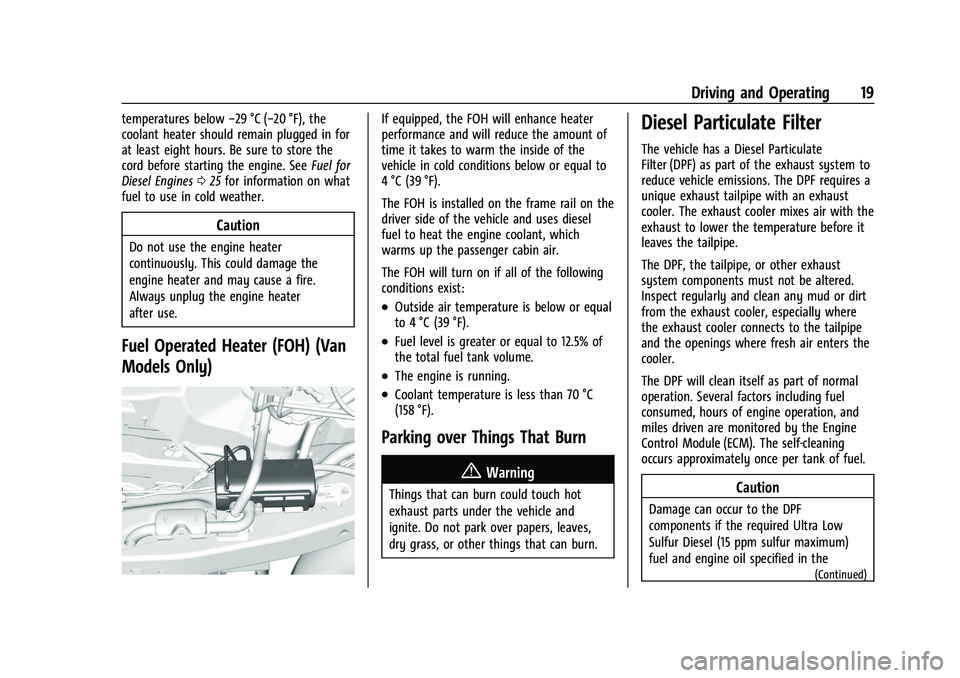
Chevrolet/GMC 2.8L Duramax Diesel Engine Supplement (GMNA-Localizing-
U.S./Canada-14465442) - 2021 - CRC - 2/3/20
Driving and Operating 19
temperatures below−29 °C (−20 °F), the
coolant heater should remain plugged in for
at least eight hours. Be sure to store the
cord before starting the engine. See Fuel for
Diesel Engines 025 for information on what
fuel to use in cold weather.
Caution
Do not use the engine heater
continuously. This could damage the
engine heater and may cause a fire.
Always unplug the engine heater
after use.
Fuel Operated Heater (FOH) (Van
Models Only)
If equipped, the FOH will enhance heater
performance and will reduce the amount of
time it takes to warm the inside of the
vehicle in cold conditions below or equal to
4 °C (39 °F).
The FOH is installed on the frame rail on the
driver side of the vehicle and uses diesel
fuel to heat the engine coolant, which
warms up the passenger cabin air.
The FOH will turn on if all of the following
conditions exist:
.Outside air temperature is below or equal
to 4 °C (39 °F).
.Fuel level is greater or equal to 12.5% of
the total fuel tank volume.
.The engine is running.
.Coolant temperature is less than 70 °C
(158 °F).
Parking over Things That Burn
{Warning
Things that can burn could touch hot
exhaust parts under the vehicle and
ignite. Do not park over papers, leaves,
dry grass, or other things that can burn.
Diesel Particulate Filter
The vehicle has a Diesel Particulate
Filter (DPF) as part of the exhaust system to
reduce vehicle emissions. The DPF requires a
unique exhaust tailpipe with an exhaust
cooler. The exhaust cooler mixes air with the
exhaust to lower the temperature before it
leaves the tailpipe.
The DPF, the tailpipe, or other exhaust
system components must not be altered.
Inspect regularly and clean any mud or dirt
from the exhaust cooler, especially where
the exhaust cooler connects to the tailpipe
and the openings where fresh air enters the
cooler.
The DPF will clean itself as part of normal
operation. Several factors including fuel
consumed, hours of engine operation, and
miles driven are monitored by the Engine
Control Module (ECM). The self-cleaning
occurs approximately once per tank of fuel.
Caution
Damage can occur to the DPF
components if the required Ultra Low
Sulfur Diesel (15 ppm sulfur maximum)
fuel and engine oil specified in the
(Continued)
Page 21 of 89
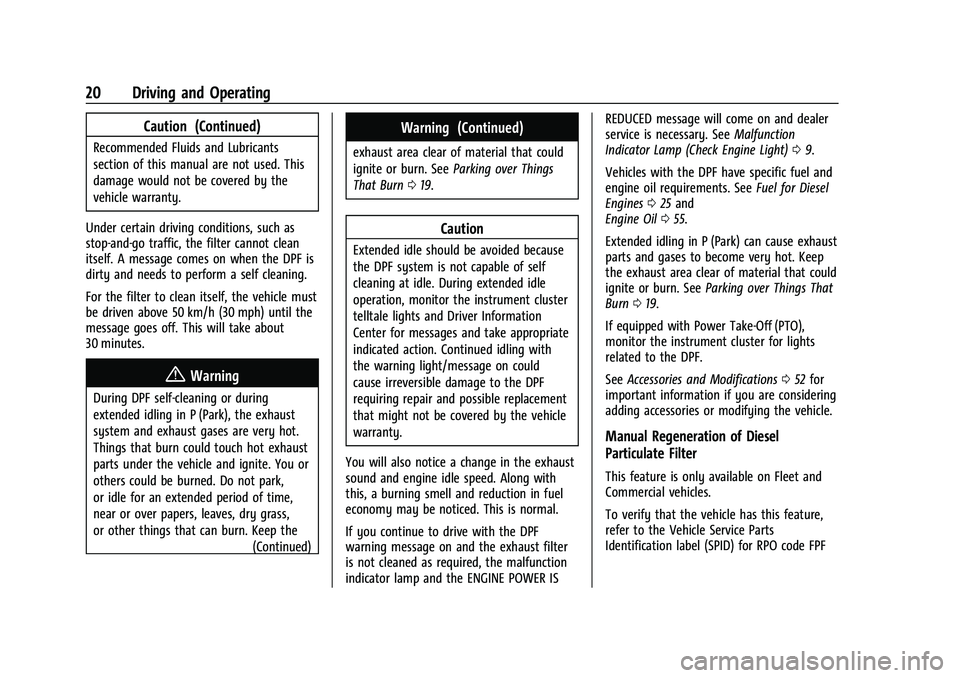
Chevrolet/GMC 2.8L Duramax Diesel Engine Supplement (GMNA-Localizing-
U.S./Canada-14465442) - 2021 - CRC - 2/3/20
20 Driving and Operating
Caution (Continued)
Recommended Fluids and Lubricants
section of this manual are not used. This
damage would not be covered by the
vehicle warranty.
Under certain driving conditions, such as
stop-and-go traffic, the filter cannot clean
itself. A message comes on when the DPF is
dirty and needs to perform a self cleaning.
For the filter to clean itself, the vehicle must
be driven above 50 km/h (30 mph) until the
message goes off. This will take about
30 minutes.
{Warning
During DPF self-cleaning or during
extended idling in P (Park), the exhaust
system and exhaust gases are very hot.
Things that burn could touch hot exhaust
parts under the vehicle and ignite. You or
others could be burned. Do not park,
or idle for an extended period of time,
near or over papers, leaves, dry grass,
or other things that can burn. Keep the (Continued)
Warning (Continued)
exhaust area clear of material that could
ignite or burn. SeeParking over Things
That Burn 019.
Caution
Extended idle should be avoided because
the DPF system is not capable of self
cleaning at idle. During extended idle
operation, monitor the instrument cluster
telltale lights and Driver Information
Center for messages and take appropriate
indicated action. Continued idling with
the warning light/message on could
cause irreversible damage to the DPF
requiring repair and possible replacement
that might not be covered by the vehicle
warranty.
You will also notice a change in the exhaust
sound and engine idle speed. Along with
this, a burning smell and reduction in fuel
economy may be noticed. This is normal.
If you continue to drive with the DPF
warning message on and the exhaust filter
is not cleaned as required, the malfunction
indicator lamp and the ENGINE POWER IS REDUCED message will come on and dealer
service is necessary. See
Malfunction
Indicator Lamp (Check Engine Light) 09.
Vehicles with the DPF have specific fuel and
engine oil requirements. See Fuel for Diesel
Engines 025 and
Engine Oil 055.
Extended idling in P (Park) can cause exhaust
parts and gases to become very hot. Keep
the exhaust area clear of material that could
ignite or burn. See Parking over Things That
Burn 019.
If equipped with Power Take-Off (PTO),
monitor the instrument cluster for lights
related to the DPF.
See Accessories and Modifications 052 for
important information if you are considering
adding accessories or modifying the vehicle.
Manual Regeneration of Diesel
Particulate Filter
This feature is only available on Fleet and
Commercial vehicles.
To verify that the vehicle has this feature,
refer to the Vehicle Service Parts
Identification label (SPID) for RPO code FPF
Page 31 of 89

Chevrolet/GMC 2.8L Duramax Diesel Engine Supplement (GMNA-Localizing-
U.S./Canada-14465442) - 2021 - CRC - 2/3/20
30 Driving and Operating
The system is not harmed by air in the fuel
lines; however, the engine and/or the FOH
may not start until the fuel system is
primed and the air is removed.
Priming the Fuel System
There is an electric priming pump that will
bring fuel to the engine and eliminate air in
the fuel lines. To prime the engine:1. Correct any condition that caused the loss of prime.
2. Turn the ignition on for 30 seconds. Do not start the engine. The fuel pump will
start priming.
3. Turn the ignition off, then back to start, and crank the engine for 15 seconds.
4. If the engine does not start, repeat Steps 2 and 3 until the engine starts.
If the engine does not start after
repeating Steps 2 and 3 three times, turn
the ignition key off for 60 seconds.
5. Repeat the above steps until the engine starts.
6. If the engine starts, but does not run smoothly, increase the engine speed
slightly. 7. If the engine starts and runs but stalls
again, turn the ignition off for
60 seconds.
8. When the engine starts, let it idle for a few minutes and check the filter for any
leaks.
To Prime the Fuel Operated Heater (FOH)
Fuel Lines (Van Models)
See your dealer or qualified technician if the
FOH fuel lines need to be primed.
Running Out of Fuel
If the engine has stalled due to running out
of fuel, try to restart it: 1. If parked on a level surface, add at least 3.8 L (1 gal) of fuel. Up to 18.9 L (5 gal)
may be needed if parked on a slope.
2. Follow the vehicle fuel system priming procedure earlier in this section to
re-prime the system and restart the
engine.
If the check engine light comes on due to
running out of fuel, it may take a few drive
cycles to clear.
On van models only, the Fuel Operated
Heater (FOH) stops automatically when the
fuel tank volume is less than or equal to 10% of the total tank. The FOH fuel lines
will not need to be primed if the vehicle
runs out of fuel.
Fuel Filter Replacement
Van Models
{Warning
Diesel fuel is flammable. It could start a
fire if something ignites it, and people
could be burned. Do not let it get on hot
engine parts, and keep matches or other
ignition sources away.
The fuel filter is on the driver side, inside
the frame rail.
To replace the fuel filter: 1. Drain any water from the filter. See “Removing Water from the Fuel Filter” in
Water in Fuel 027.
Keep the engine off until the procedure
is completed.
2. Apply the parking brake.
Page 39 of 89
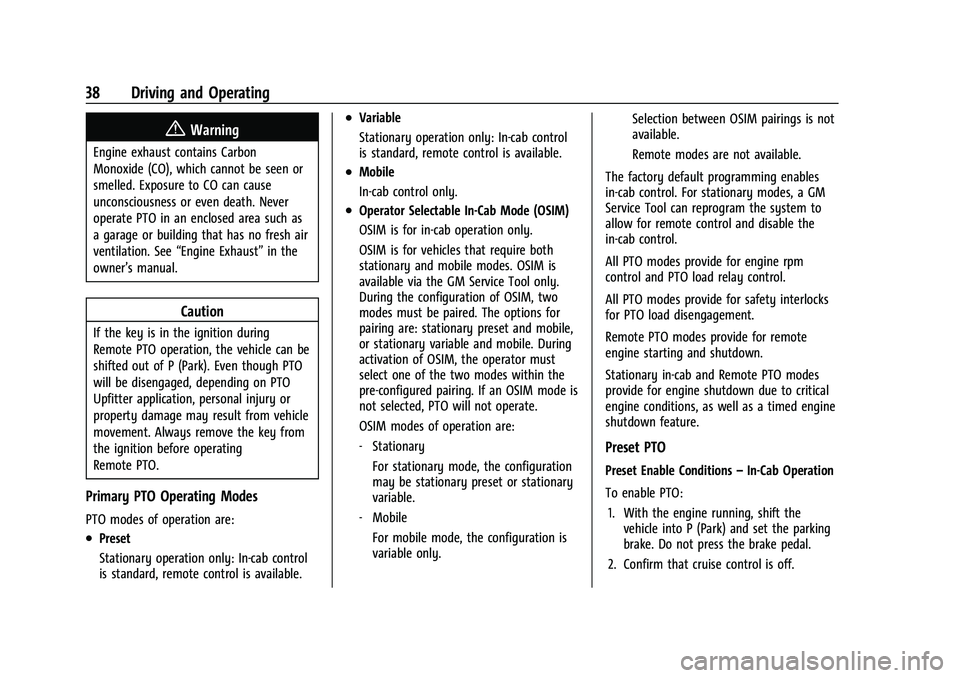
Chevrolet/GMC 2.8L Duramax Diesel Engine Supplement (GMNA-Localizing-
U.S./Canada-14465442) - 2021 - CRC - 2/3/20
38 Driving and Operating
{Warning
Engine exhaust contains Carbon
Monoxide (CO), which cannot be seen or
smelled. Exposure to CO can cause
unconsciousness or even death. Never
operate PTO in an enclosed area such as
a garage or building that has no fresh air
ventilation. See“Engine Exhaust” in the
owner’s manual.
Caution
If the key is in the ignition during
Remote PTO operation, the vehicle can be
shifted out of P (Park). Even though PTO
will be disengaged, depending on PTO
Upfitter application, personal injury or
property damage may result from vehicle
movement. Always remove the key from
the ignition before operating
Remote PTO.
Primary PTO Operating Modes
PTO modes of operation are:
.Preset
Stationary operation only: In-cab control
is standard, remote control is available.
.Variable
Stationary operation only: In-cab control
is standard, remote control is available.
.Mobile
In-cab control only.
.Operator Selectable In-Cab Mode (OSIM)
OSIM is for in-cab operation only.
OSIM is for vehicles that require both
stationary and mobile modes. OSIM is
available via the GM Service Tool only.
During the configuration of OSIM, two
modes must be paired. The options for
pairing are: stationary preset and mobile,
or stationary variable and mobile. During
activation of OSIM, the operator must
select one of the two modes within the
pre-configured pairing. If an OSIM mode is
not selected, PTO will not operate.
OSIM modes of operation are:
‐ Stationary
For stationary mode, the configuration
may be stationary preset or stationary
variable.
‐ Mobile
For mobile mode, the configuration is
variable only. Selection between OSIM pairings is not
available.
Remote modes are not available.
The factory default programming enables
in-cab control. For stationary modes, a GM
Service Tool can reprogram the system to
allow for remote control and disable the
in-cab control.
All PTO modes provide for engine rpm
control and PTO load relay control.
All PTO modes provide for safety interlocks
for PTO load disengagement.
Remote PTO modes provide for remote
engine starting and shutdown.
Stationary in-cab and Remote PTO modes
provide for engine shutdown due to critical
engine conditions, as well as a timed engine
shutdown feature.
Preset PTO
Preset Enable Conditions –In-Cab Operation
To enable PTO: 1. With the engine running, shift the vehicle into P (Park) and set the parking
brake. Do not press the brake pedal.
2. Confirm that cruise control is off.
Page 41 of 89
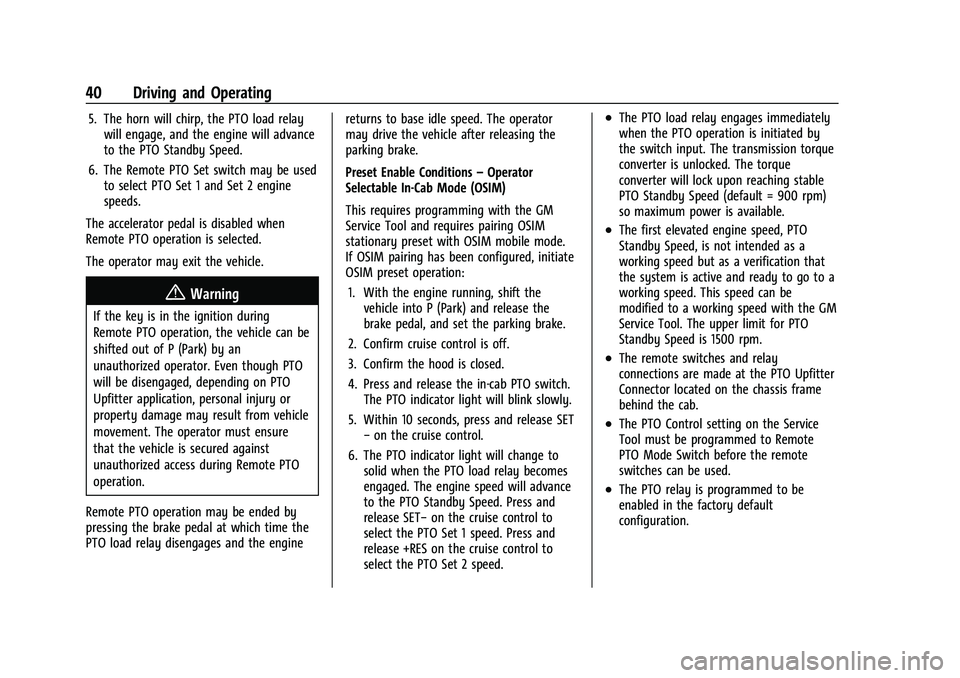
Chevrolet/GMC 2.8L Duramax Diesel Engine Supplement (GMNA-Localizing-
U.S./Canada-14465442) - 2021 - CRC - 2/3/20
40 Driving and Operating
5. The horn will chirp, the PTO load relaywill engage, and the engine will advance
to the PTO Standby Speed.
6. The Remote PTO Set switch may be used to select PTO Set 1 and Set 2 engine
speeds.
The accelerator pedal is disabled when
Remote PTO operation is selected.
The operator may exit the vehicle.
{Warning
If the key is in the ignition during
Remote PTO operation, the vehicle can be
shifted out of P (Park) by an
unauthorized operator. Even though PTO
will be disengaged, depending on PTO
Upfitter application, personal injury or
property damage may result from vehicle
movement. The operator must ensure
that the vehicle is secured against
unauthorized access during Remote PTO
operation.
Remote PTO operation may be ended by
pressing the brake pedal at which time the
PTO load relay disengages and the engine returns to base idle speed. The operator
may drive the vehicle after releasing the
parking brake.
Preset Enable Conditions
–Operator
Selectable In-Cab Mode (OSIM)
This requires programming with the GM
Service Tool and requires pairing OSIM
stationary preset with OSIM mobile mode.
If OSIM pairing has been configured, initiate
OSIM preset operation:
1. With the engine running, shift the vehicle into P (Park) and release the
brake pedal, and set the parking brake.
2. Confirm cruise control is off.
3. Confirm the hood is closed.
4. Press and release the in-cab PTO switch. The PTO indicator light will blink slowly.
5. Within 10 seconds, press and release SET −on the cruise control.
6. The PTO indicator light will change to solid when the PTO load relay becomes
engaged. The engine speed will advance
to the PTO Standby Speed. Press and
release SET− on the cruise control to
select the PTO Set 1 speed. Press and
release +RES on the cruise control to
select the PTO Set 2 speed.
.The PTO load relay engages immediately
when the PTO operation is initiated by
the switch input. The transmission torque
converter is unlocked. The torque
converter will lock upon reaching stable
PTO Standby Speed (default = 900 rpm)
so maximum power is available.
.The first elevated engine speed, PTO
Standby Speed, is not intended as a
working speed but as a verification that
the system is active and ready to go to a
working speed. This speed can be
modified to a working speed with the GM
Service Tool. The upper limit for PTO
Standby Speed is 1500 rpm.
.The remote switches and relay
connections are made at the PTO Upfitter
Connector located on the chassis frame
behind the cab.
.The PTO Control setting on the Service
Tool must be programmed to Remote
PTO Mode Switch before the remote
switches can be used.
.The PTO relay is programmed to be
enabled in the factory default
configuration.
Page 43 of 89

Chevrolet/GMC 2.8L Duramax Diesel Engine Supplement (GMNA-Localizing-
U.S./Canada-14465442) - 2021 - CRC - 2/3/20
42 Driving and Operating
Warning (Continued)
that the vehicle is secured against
unauthorized access during Remote PTO
operation.
The accelerator pedal is disabled when
Remote PTO operation is selected.
Remote PTO operation can be ended by
pressing the brake pedal. The PTO load relay
disengages and the engine returns to base
idle speed. The operator may drive the
vehicle after releasing the parking brake.
.The desired engine operating speed can
now be accomplished. Two versions of
engine rpm control are available, switches
or potentiometer, depending on which
one was installed.
‐ Switches –the Remote PTO Set and
Resume switches can be used to tap up
and tap down to the desired engine
speed.
‐ Potentiometer –a Remote PTO Throttle
Potentiometer can be used as a
continuous variable throttle control to
dial in the desired engine speed. Variable Enable Conditions
–OSIM
This requires programming with the GM
Service Tool and specific pairing of
stationary variable and mobile modes.
Remote operation is not available.
If OSIM pairing has been configured, initiate
OSIM stationary variable operation: 1. With the engine running, shift the vehicle into P (Park), release the brake
pedal, and set the parking brake.
2. Confirm cruise control is off.
3. Confirm the hood is closed.
4. Press and release the PTO in-cab switch. The PTO indicator light will blink slowly.
5. Within 10 seconds, press and release SET− on the cruise control. The PTO load
relay will engage and the PTO indicator
light will change to solid. The engine
speed will advance to the PTO Standby
Speed.
6. The desired operating speed may be achieved by tapping up and down with
+RES and SET− on the cruise control.
.The PTO load relay engages immediately
when the PTO operation is initiated by
the switch input. The transmission torque
converter is unlocked. The torque converter will lock upon reaching stable
PTO Standby Speed (default = 900 rpm)
so maximum power is available.
.The first elevated engine speed, PTO
Standby Speed, is not intended as a
working speed but as a verification that
the system is active and ready to go to a
working speed.
.The relay connections are made at the
PTO Upfitter Connector located on the
chassis frame behind the cab.
.The engine speeds can be adjusted
between the low of PTO Standby Speed
and the high of PTO Max Engine speed
limits. Both values can be modified from
the factory default settings with the GM
Service Tool. Based on the value chosen
for PTO Max Engine Speed, the PTO menu
in the center stack may show speeds that
are not available.
.Factory setting for the tap step is 100
rpm and the setting for ramp rate is 150
rpm/sec. The default value for tap step
can be modified via the Radio
Customization menu. The default values
for both tap step and ramp rate can be
changed with the GM Service Tool.
.The PTO load relay is enabled as the
factory default programmed setting.